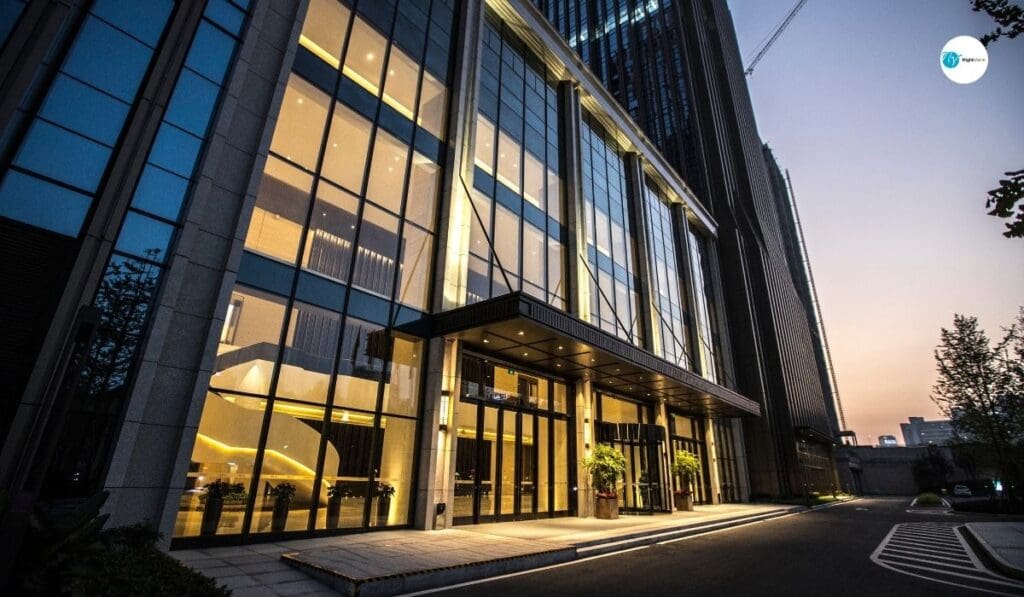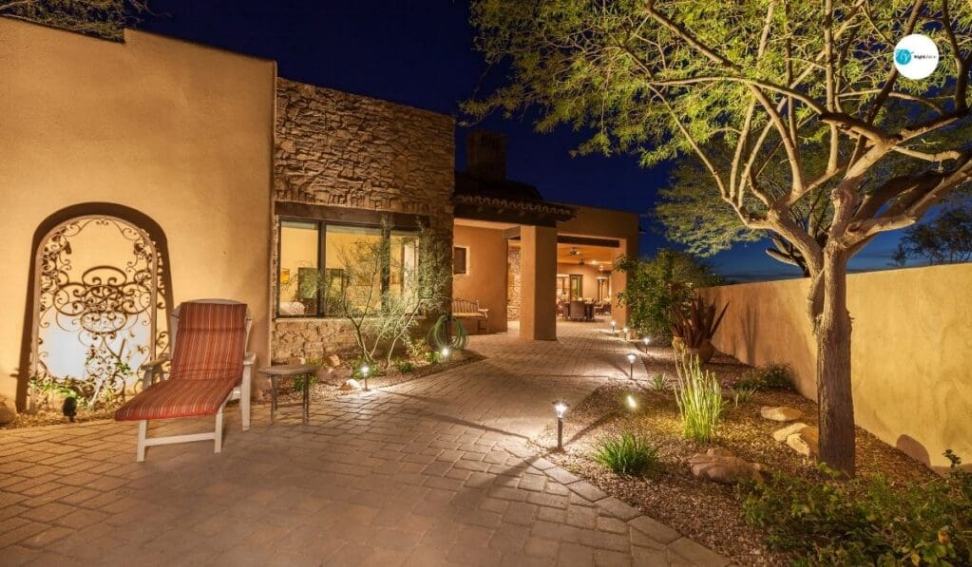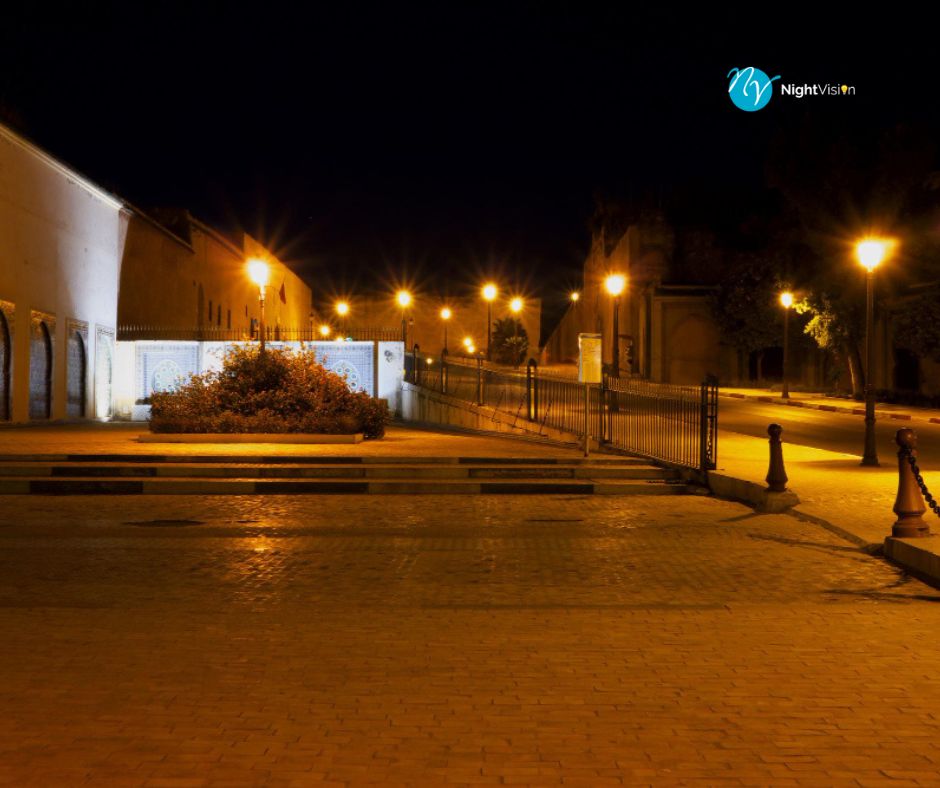Landscape lighting can dramatically enhance the ambiance and functionality of commercial spaces, creating an inviting atmosphere while showcasing architectural features and landscaping elements.
However, achieving optimal results requires careful planning and execution.
In this article, we’ll explore critical tips for designing commercial landscape lighting that illuminates excellence.
Understand the Purpose
Understanding the purpose of commercial landscape lighting sets the foundation for a successful design.
Each lighting objective carries its own set of requirements and considerations, influencing the overall layout and selection of fixtures.
Enhancing security is often a primary concern for commercial spaces, especially those with nighttime foot traffic or valuable assets.
Lighting can deter unwanted activity by illuminating dark corners and potential hiding spots, while strategically placed fixtures can provide clear visibility for security cameras and personnel.
Highlighting architectural elements adds character and visual interest to the property, drawing attention to unique features and creating a memorable impression.
Whether it’s a building’s grand façade, intricate stonework, or striking sculptures, lighting can accentuate these elements, transforming the space into a captivating showcase of design and craftsmanship.
Assess the Site

Conducting a comprehensive site assessment lays the groundwork for an effective commercial landscape lighting design.
It involves a detailed examination of various aspects of the property to gain a thorough understanding of its layout, features, and potential challenges.
Start by identifying key features such as walkways, entry points, and focal points that require illumination.
Walkways, for example, need adequate lighting to ensure safe pedestrian navigation, while entry points serve as focal areas that can benefit from decorative or accent lighting to create a welcoming ambiance.
Consider the space’s layout and how people move through it.
Understanding traffic flow patterns helps determine where lighting fixtures should be placed for optimal visibility and functionality.
Areas with heavy foot traffic may require brighter, more evenly distributed lighting, while less frequented areas can be illuminated with softer, ambient lighting.
Balance Functionality and Aesthetics
Finding the perfect balance between functionality and aesthetics is essential in commercial landscape lighting design.
While the primary purpose of lighting is to ensure safety and security by illuminating pathways and parking areas, it’s equally important to consider the visual impact and ambiance it creates.
Functional lighting serves practical purposes, such as guiding pedestrians safely through the space and providing visibility for vehicles in parking areas.
These areas require consistent, uniform illumination to minimize shadows and ensure clear visibility at all times, especially during nighttime hours or in low-light conditions.
Layering and Depth
Layering and depth are critical elements in commercial landscape lighting design, allowing for the creation of visually stunning and functional outdoor environments.
By incorporating multiple layers of lighting, designers can enhance the overall ambiance, highlight critical features, and improve visibility throughout the space.
Ambient lighting serves as the foundation of the lighting scheme, providing general illumination to the entire area.
It creates a sense of warmth and comfort, making the space feel inviting and welcoming.
Ambient lighting is typically achieved through overhead fixtures, such as post lights or wall-mounted lanterns, that evenly distribute light across the landscape.
Task lighting serves specific functional purposes, addressing the space’s practical needs.
This can include illuminating signage, seating areas, or other functional zones where increased visibility is required.
Task lighting ensures that these areas are well-lit and easily accessible, enhancing usability and convenience for visitors and patrons.
Utilize Different Light Sources
Utilizing a variety of light sources is essential for achieving the desired lighting effects in commercial landscape design.
Each type of light source offers unique characteristics and benefits that can enhance the overall ambiance and functionality of outdoor spaces.
LED lighting has become increasingly popular in commercial applications due to its energy efficiency, longevity, and versatility.
LED fixtures consume less energy than traditional lighting sources, resulting in lower operating costs and reduced environmental impact.
Additionally, LED lights have a long lifespan, reducing the need for frequent replacements and maintenance.
Their versatility allows for precise control of color temperature and intensity, making them suitable for a wide range of applications, from general illumination to accent lighting.
Consider Color Temperature
Color temperature plays a crucial role in setting the mood and ambiance of outdoor spaces in commercial landscape lighting design.
By carefully considering the color temperature of lighting fixtures, designers can create environments that evoke specific emotions and enhance the overall experience for visitors and patrons.
Warm white light, typically in the range of 2700-3000 Kelvin (K), emits a soft, golden glow that creates a cozy and inviting atmosphere.
This warm hue is reminiscent of candlelight or incandescent bulbs, making it well-suited for outdoor dining areas, gathering spaces, and other places where comfort and relaxation are desired.
Warm white light enhances the beauty of natural materials and earth tones, creating a welcoming ambiance that encourages social interaction and relaxation.
Incorporate Smart Technology
Incorporating innovative technology into commercial landscape lighting offers numerous benefits, including enhanced convenience, efficiency, and control.
By leveraging programmable timers, motion sensors, and remote control capabilities, businesses can optimize their lighting systems to meet specific needs while minimizing energy consumption and environmental impact.
Programmable timers allow users to schedule lighting operations according to predefined schedules, ensuring that lights are activated and deactivated automatically at specific times.
This feature is handy for outdoor spaces that have predictable usage patterns, such as parking lots or building entrances.
By programming the lighting schedule to align with operational hours, businesses can ensure that lights are only in use when needed, reducing energy waste and lowering utility costs.
Maintain Accessibility and Safety

Maintaining accessibility and safety is paramount when designing commercial landscape lighting.
It’s essential to ensure that the lighting design adheres to accessibility and safety standards, especially in high-traffic areas and pathways where pedestrian safety is a primary concern.
One critical consideration is to avoid creating glare or shadows that could obstruct visibility or cause accidents.
Glare occurs when lighting fixtures emit excessive brightness, making it difficult for pedestrians to see clearly.
To minimize glare, designers can use shields or diffusers to direct light downward and reduce direct glare.
Additionally, positioning fixtures strategically to minimize obstructions and shadows helps maintain clear visibility and ensure safe passage for pedestrians.
Conclusion
In conclusion, designing commercial landscape lighting that illuminates excellence requires careful planning, attention to detail, and a commitment to quality and sustainability.
By incorporating these tips and principles into your lighting design process, you can create a captivating and functional outdoor environment that enhances the customer experience, improves safety and security, and reinforces the brand identity of your commercial property.
With thoughtful consideration of aesthetics, functionality, and efficiency, you can achieve outstanding results that set your business apart and create a lasting impression on visitors and patrons alike.
For expert assistance in designing your commercial landscape lighting, contact us at NightVision Outdoor Lighting.
FAQs
What is the importance of understanding the purpose of commercial landscape lighting?
Understanding the purpose of commercial landscape lighting is crucial as it forms the foundation of a successful design. It helps in identifying specific requirements and considerations based on lighting objectives, such as enhancing security or highlighting architectural elements.
What are some key considerations during the site assessment phase of commercial landscape lighting design?
During the site assessment, it’s essential to identify key features that require illumination, understand traffic flow patterns, and assess potential challenges such as dark corners or obstructions. This comprehensive examination provides insights into the layout and characteristics of the space, informing the lighting design process.
How can commercial landscape lighting balance functionality and aesthetics?
Commercial landscape lighting should strike a balance between functionality and aesthetics. While ensuring safety and security through consistent illumination, it’s also essential to consider the visual impact and ambiance created by the lighting scheme. This balance enhances the space’s practicality and attractiveness.
What role do layering and depth play in commercial landscape lighting design?
Layering and depth are essential elements in creating visually stunning and functional outdoor environments. By incorporating multiple layers of lighting, designers can enhance ambiance, highlight key features, and improve visibility throughout the space, creating a dynamic and engaging atmosphere.
Why is it important to utilize different light sources in commercial landscape lighting design?
Utilizing a variety of light sources allows designers to achieve diverse lighting effects and meet the space’s specific requirements. Different light sources offer unique characteristics and benefits, such as energy efficiency, versatility, and precise control, contributing to the overall effectiveness of the lighting design.
What role does color temperature play in commercial landscape lighting?
Color temperature influences the mood and ambiance of outdoor spaces, affecting the overall experience for visitors and patrons. By carefully selecting lighting fixtures with appropriate color temperatures, designers can create environments that evoke specific emotions and enhance the desired atmosphere, whether it’s cozy and inviting or vibrant and energetic.
How can businesses benefit from incorporating innovative technology into their commercial landscape lighting systems?
Incorporating innovative technology offers numerous benefits, including enhanced convenience, efficiency, and control. By leveraging features such as programmable timers, motion sensors, and remote control capabilities, businesses can optimize their lighting systems to meet specific needs, minimize energy consumption, and improve overall management and maintenance.
What considerations are essential for maintaining accessibility and safety in commercial landscape lighting design?
Maintaining accessibility and safety involves ensuring that the lighting design adheres to relevant standards and guidelines, avoiding glare or shadows that could obstruct visibility or cause accidents. Strategic positioning of fixtures, use of shields or diffusers to minimize glare, and adherence to accessibility standards are critical considerations for ensuring safe passage for pedestrians.



